Nelson Monzón, Javier Sánchez and Agustín Salgado
Centro de Tecnologías de la Imagen
University of Las Palmas de Gran Canaria
35017 Las Palmas de Gran Canaria, Spain
Introduction
We analyse the influence of colour information in optical flow methods.
Typically, most of these techniques compute their solutions using grayscale intensities due to its simplicity and faster processing, ignoring the colour features.
However, the current processing systems have minimized their computational cost and, on the other hand, it is reasonable to assume that a colour image offers more details from the scene which should facilitate finding better flow fields. The aim of this work is to determine if a multi-channel approach supposes a quite enough improvement to justify its use.
In order to address this evaluation, we use a multi-channel implementation of a well-known TV-L
1 method.
Furthermore, we review in the original work the state-of-the-art in colour optical flow methods.
In the experiments, we study various solutions using grayscale and RGB images from recent evaluation datasets to verify the colour benefits in motion estimation.
Download full text
[1]
Monzón López, N,
Sánchez Pérez, J&
Salgado de la Nuez, A.J.. (2012)
Implementation of a Robust Optical Flow Method for Color Images.
CTIM Technical Report.(4).Universidad de Las Palmas de Gran Canaria.
Download source code
In this page you can find the code of a multi-channel implementation of a variational technique to determine if the colour information benefits the optical flow calculation.
We perform our evaluation with some widely used sequences from the Middlebury benchmark database and the open source movies from the MPI-Sintel flow data set.
The code is developed in standard C++ and it has been compiled in Windows and Linux, using the GNU gcc compiler.
multichannel_robust_optic_flow.zip
The software is released under the
BSD license
You can compile it executing make on the console
Energy model
Let
I(
x): Ω ⊂ R
3 → R be an image sequence, with
x=(x,y,t)
T ∈ Ω,
I={I
c}
{c=1,...,C} and C the number of channels.
We define the optical flow as a dense mapping,
w(
x)}=(u(
x),v(
x),1)
T, between every two consecutive images, where u(
x) and v(
x) are the vector fields that represent the
x and
y displacements, respectively.
We use ∇
I= (I
cx,I
cy)
T{c=1,...,C} to denote the spatial gradient of the image, with I
cx, I
cy the first order derivatives in
x and
y for each information channel.
Following the original model, we assume that the brightness constancy assumption is also fulfilled in the multi-channel scheme. Then, according to this notation, our energy functional reads as:

where

as a robustification function and ε as a prefixed small constant to ensure that this function is strictly convex. We use the Euclidean norm,

The energy model of Brox
et al uses brightness and gradient constancy assumptions in the data term and a TV scheme for smoothing. It depends on the γ and α parameters for controlling the gradient and the smoothness strength, respectively.
Notice that the influence of γ is increased proportional to the number of channels. We compensate this situation by adapting the smoothness parameter α, therefore, α = α
′ ∙ C, being α
′ ∙ an input parameter. An example of this multi-channel scheme can be seen in Fig 1.
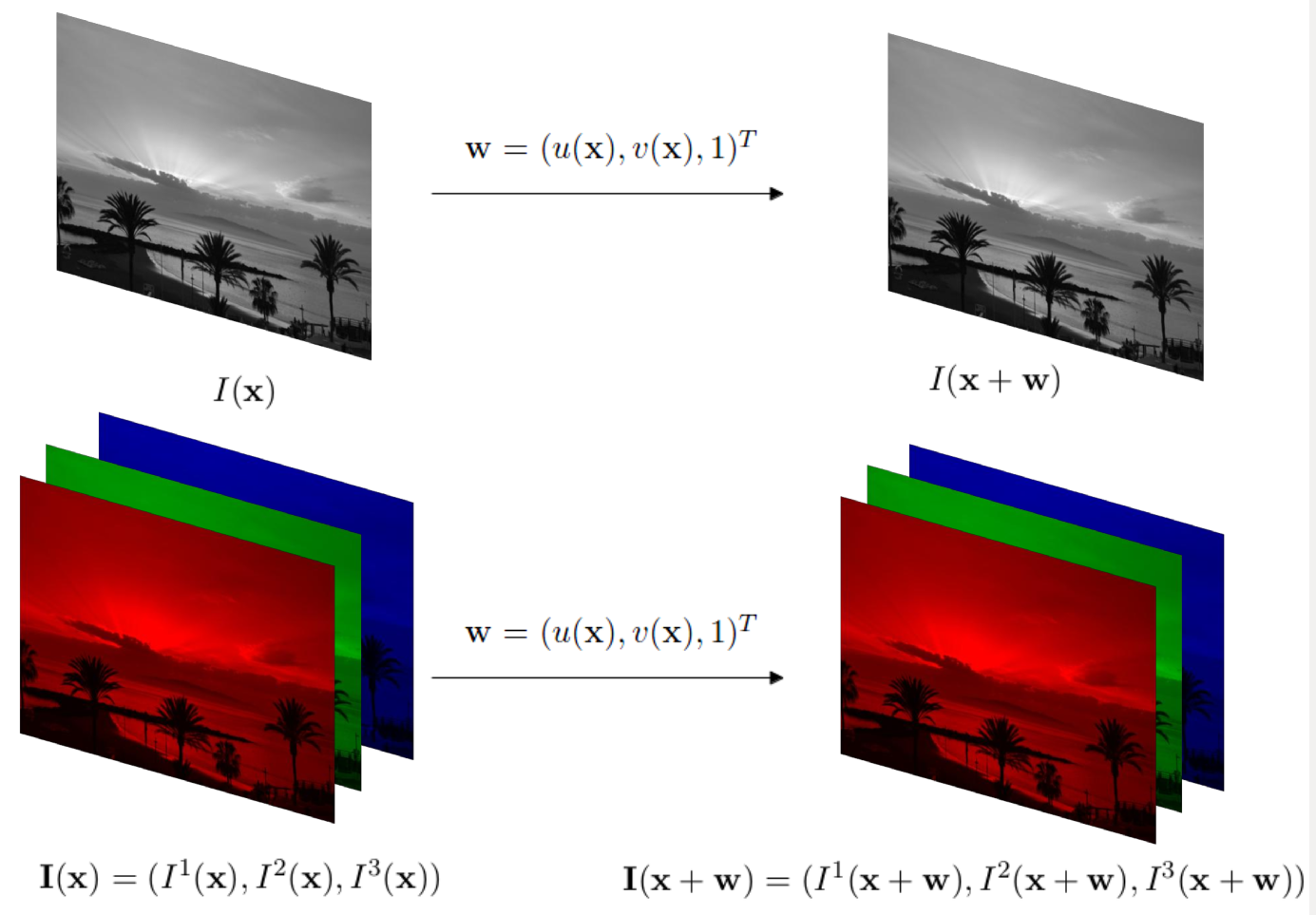
|
|
Fig. 1. Notation for grayscale and colour images.
|
Experimental Results
This subsection presents an evaluation of the possible benefits of colour against grayscale information in a variational optical flow method.
We show the experiments for some synthetic sequences from the Middlebury benchmark database and MPI-Sintel dataset using RGB and grayscale images.
The purpose of these tests is to compare motion details between the best flows achieved for the same sequence.
Figures 2, 3 and 4 show the results for the Middlebury sequences of
Grove3,
RubberWhale and
Urban2, respectively. On the other hand, Figures 5, 6 and 7 depict the best flows and its details for the sequences of
Bandage 1,
Bandage 2 and
Ambush 5 from MPI-Sintel dataset.
In the first column of these figures, we show the colour scheme used for the optical flow representation, the grayscale and the colour images.
In the second column, we depict the ground truth and the motion fields for grayscale and RGB, respectively.
The remaining columns present motion details for the corresponding solutions.
The colour scheme represents the orientation and magnitude of the vector field.
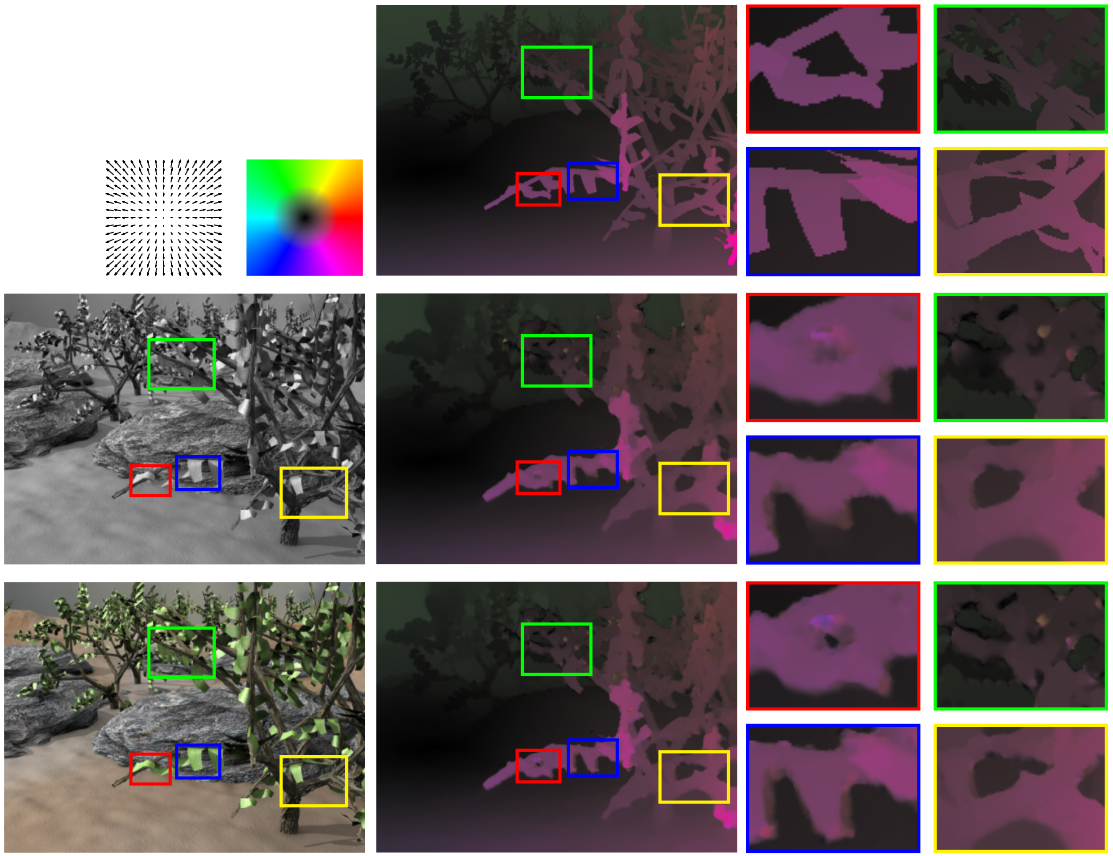
|
|
Fig. 2. Motion details for the Grove3 sequence.
|
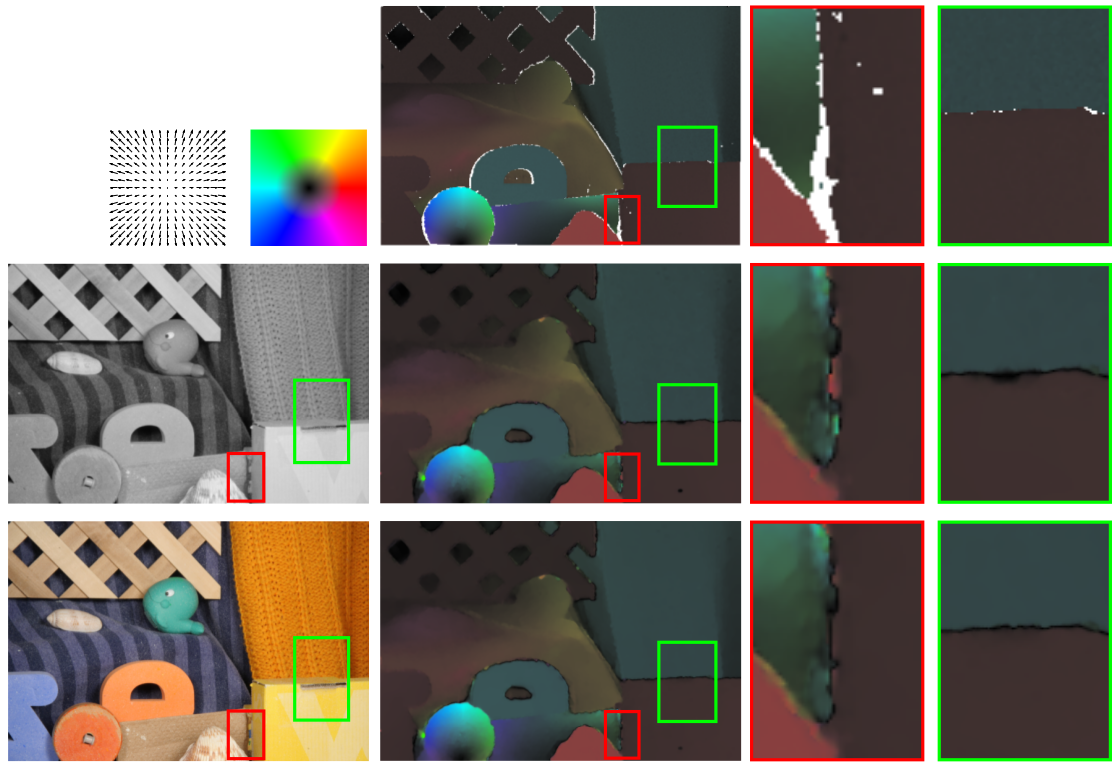
|
|
Fig. 3. Motion details for the RubberWhale sequence.
|
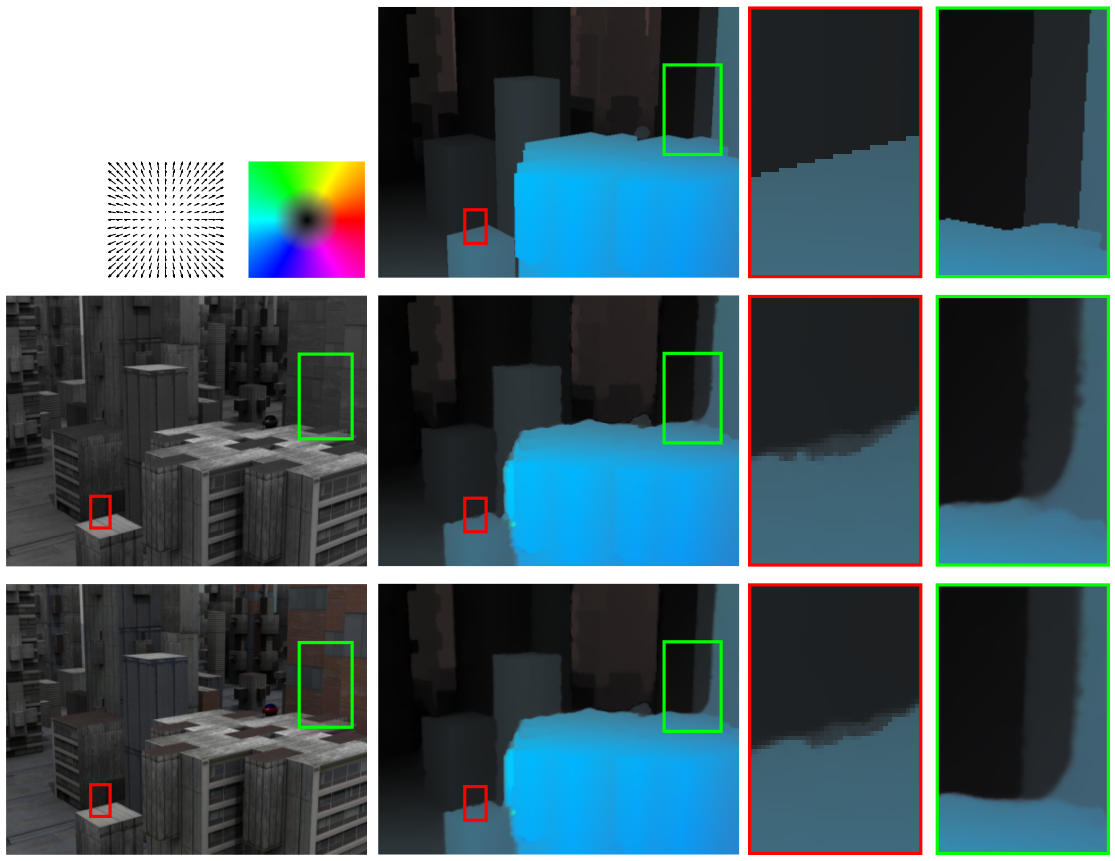
|
|
Fig. 4. Motion details for the Urban2 sequence.
|
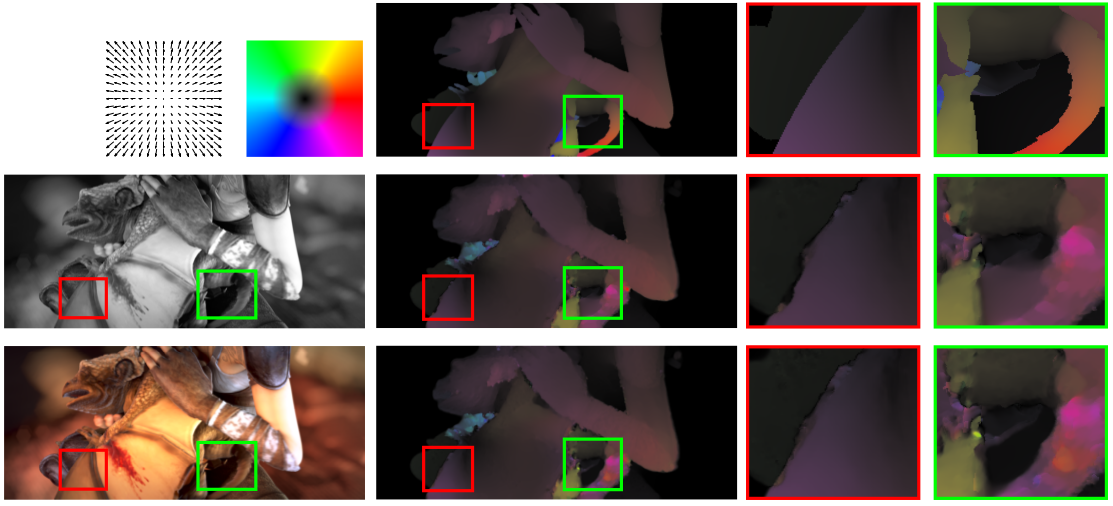
|
|
Fig. 5. Motion details for the Bandage 1 sequence.
|
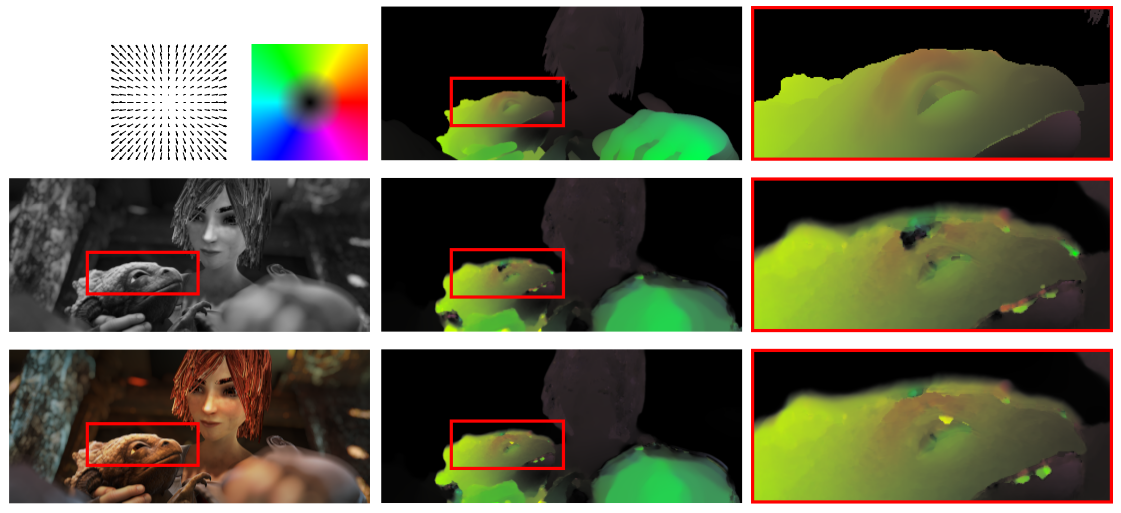
|
|
Fig. 6. Motion details for the Bandage 2 sequence.
|
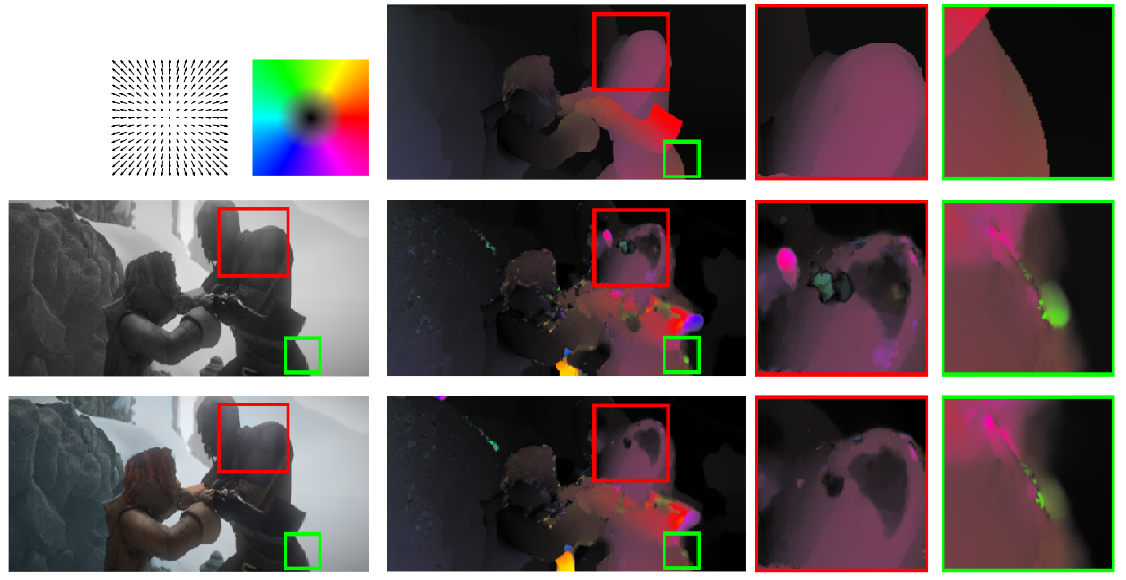
|
|
Fig. 7. Motion details for the Ambush 5 sequence.
|
According to the results, we conclude that the colour information benefits the optical flow estimation.
In general, the motion boundaries are better preserved and the error decreases perceptibly, especially in Figures 2 and 7.
Quantitative Results
Next, we show the numerical results provided by the best configurations of α and γ to compare the accuracy of using colour or grayscale in these two datasets.
On the other hand, it is interesting to take into account the running times required by the method to justify if the computational cost its reasonable.
First, we depict in Tables 1 and 2 the Average Angular Error (AAE) and the End Point Error (EPE) results for the best settings using the grayscale and colour sequences.
The last two columns of these figures show the percentage of error variation between the colour spaces.
Observing the results, we can state that the RGB information improves the numerical errors, especially in the Middlebury sequences where most of the amelioration in the EPE exceeds in 5.50% and the AAE in 4%.
Moreover, the enhancement is not so evident in the MPI Sintel sequences.
It can be appreciated that, in a few occasions, the colour worsens the EPE.
Nevertheless, this deterioration is not excessive and the colour information provides a reasonable improvement in a high percentage of cases, especially in Ambush 5 and Sleeping 1.
The experiments were realized in a computer with the following features: Intel(R) Core(TM) i7 CPU 860 @2.80GHz. We have used a single core in our tests.
| |
Grayscale |
Color (RGB) |
| Sequence |
AAE |
EPE |
AAE |
EPE |
AAE(%) |
EPE(%) |
| Grove2 |
2.198º |
0.158 |
2.169º |
0.149 |
1.34% |
2.03% |
| Grove3 |
5.971º |
0.659 |
5.661º |
0.612 |
5.48% |
7.68% |
| Hydrangea |
2.142º |
0.180 |
2.015º |
0.166 |
6.30% |
8.43% |
| RubberWhale |
3.453º |
0.103 |
3.305º |
0.097 |
4.48% |
6.18% |
| Urban2 |
2.438º |
0.359 |
2.328º |
0.340 |
4.72% |
5.59% |
| Urban3 |
3.539º |
0.386 |
3.394º |
0.401 |
4.27% |
-3.74% |
| Dimetrodon |
1.588º |
0.083 |
1.458º |
0.074 |
8.91% |
12.16% |
|
Table 1. AAE and EPE for the Middlebury dataset: configurations of the parameters that provide the best average errors.
|
| |
Grayscale |
Color (RGB) |
| Sequence |
AAE |
EPE |
AAE |
EPE |
AAE(%) |
EPE(%) |
| Alley 1 |
3.343º |
0.374 |
3.328º |
0.373 |
0.45% |
0.27% |
| Alley 2 |
3.100º |
0.270 |
3.065º |
0.612 |
5.48% |
7.68% |
| Ambush 2 |
31.83º |
25.14 |
31.12º |
25.22 |
2.28% |
-0.32% |
| Ambush 4 |
28.24º |
34.73 |
27.92º |
34.72 |
1.14% |
0.03% |
| Ambush 5 |
29.59º |
2.647 |
26.91º |
2.234 |
6.80% |
18.5% |
| Ambush 6 |
12.21º |
12.72 |
11.95º |
12.62 |
2.17% |
0.79% |
| Ambush 7 |
6.924º |
2.072 |
6.821º |
2.152 |
1.51% |
-3.72% |
| Bamboo 1 |
4.416º |
0.307 |
4.237º |
0.291 |
4.22% |
5.50% |
| Bamboo 2 |
6.334º |
0.706 |
6.084º |
0.665 |
4.10% |
4.11% |
| Bandage 1 |
7.367º |
1.061 |
7.262º |
1.030 |
1.44% |
3.01% |
| Bandage 2 |
9.403º |
1.145 |
9.242º |
1.074 |
1.74% |
6.61% |
| Cave 2 |
3.219º |
1.707 |
3.166º |
1.741 |
1.67% |
-3.72% |
| Cave 4 |
13.19º |
7.810 |
12.60º |
7.681 |
4.68% |
1.68% |
| Market 2 |
8.814º |
1.561 |
8.628º |
1.607 |
2.15% |
-2.86% |
| Market 5 |
33.68º |
27.37 |
32.84º |
25.08 |
2.55% |
9.13% |
| Market 6 |
6.491º |
9.245 |
6.070º |
9.036 |
6.93% |
2.31% |
| Mountain 1 |
6.500º |
1.407 |
6.296º |
1.273 |
3.24% |
10.5% |
| Shaman 2 |
6.367º |
0.311 |
6.335º |
0.307 |
0.50% |
1.30% |
| Shaman 3 |
6.367º |
0.508 |
6.038º |
0.520 |
1.11% |
-2.31% |
| Sleeping 1 |
1.394º |
0.113 |
1.290º |
0.104 |
8.06% |
8.65% |
| Sleeping 2 |
1.589º |
0.706 |
1.541º |
0.070 |
3.11% |
4.47% |
| Temple 2 |
7.579º |
1.438 |
7.296º |
1.456 |
3.88% |
-1.24% |
| Temple 3 |
3.165º |
0.958 |
2.991º |
0.886 |
5.82% |
8.13% |
|
Table 2. AAE and EPE for the MPI Sintel dataset: configurations of the parameters that provide the best average errors.
|
On the other hand, the error amelioration is not enough to determine if a multi-channel scheme is justified.
Thus, Tables 3 and 4 show the runtimes of each sequence and the percentage of improvement provided by the grayscale with respect to the RGB images.
As expected, less information means less execution time.
However, the difference is not excessively pronounced and, even, in the case of Ambush 2 sequence, less time is required if we use colour information.
This means that, using more information from the images, the algorithm usually converges in less iterations.
Moreover, we must consider that the increment in the calculations has only affected the data term, so that more image channels does not mean that the operations grow up proportionally.
| Sequence |
Grayscale |
Color (RGB) |
Speed (%) |
| Grove2 |
45s |
67s |
32.83% |
| Grove3 |
49s |
72s |
31.94% |
| Hydrangea |
22s |
46s |
52.17% |
| RubberWhale |
30s |
48s |
37.50% |
| Urban2 |
50s |
72s |
30.55% |
| Urban3 |
55s |
81s |
32.10% |
| Dimetrodon |
28s |
47s |
40.42% |
|
Table 3. Computation time in Middlebury sequences.
|
| Sequence |
Grayscale |
Color (RGB) |
Speed (%) |
| Alley 1 |
63s |
107s |
41.12% |
| Alley 2 |
49s |
81s |
39.51% |
| Ambush 2 |
199s |
150s |
-32.67% |
| Ambush 4 |
70s |
106s |
33.96% |
| Ambush 5 |
102s |
135s |
24.45% |
| Ambush 6 |
99s |
140s |
29.29% |
| Ambush 7 |
97s |
144s |
32.64% |
| Bamboo 1 |
64s |
116s |
44.83% |
| Bamboo 2 |
79s |
108s |
26.85% |
| Bandage 1 |
89s |
128s |
30.47% |
| Bandage 2 |
93s |
128s |
27.34% |
| Cave 2 |
84s |
113s |
25.66% |
| Cave 4 |
86s |
120s |
28.33% |
| Market 2 |
73s |
114s |
35.96% |
| Market 5 |
205s |
205s |
0.00% |
| Market 6 |
104s |
136s |
23.53% |
| Mountain 1 |
45s |
81s |
44.45% |
| Shaman 2 |
67s |
101s |
33.66% |
| Shaman 3 |
89s |
123s |
27.64% |
| Sleeping 1 |
31s |
63s |
50.79% |
| Sleeping 2 |
36s |
68s |
47.06% |
| Temple 2 |
92s |
131s |
29.77% |
| Temple 3 |
90s |
124s |
27.42% |
|
Table 4. Computation time in MPI Sintel dataset.
|










